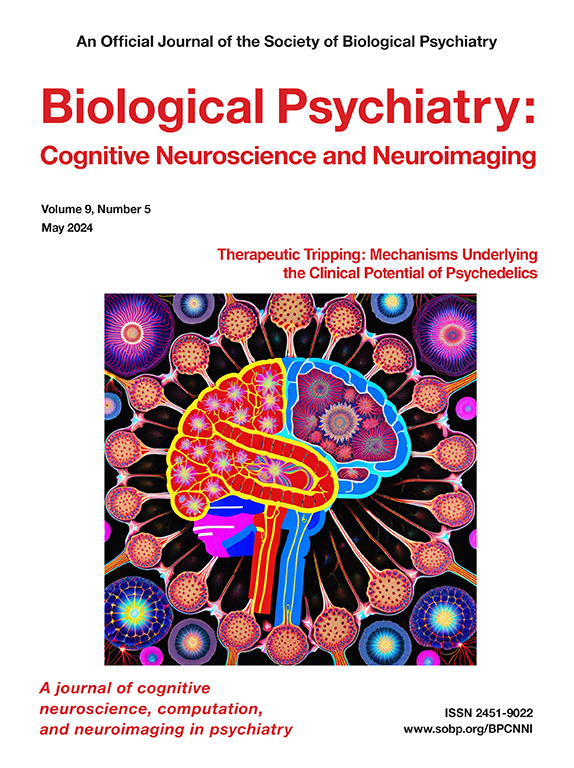不确定性处理的不同计算机制解释了焦虑和冷漠中相反的探索行为。
IF 4.8
2区 医学
Q1 NEUROSCIENCES
Biological Psychiatry-Cognitive Neuroscience and Neuroimaging
Pub Date : 2025-09-01
DOI:10.1016/j.bpsc.2025.01.005
引用次数: 0
摘要
背景:在不确定的环境中做决定会导致不同的结果,而我们如何处理这些结果可能取决于我们的情绪状态。了解个体如何解释不确定性的来源对于理解适应性行为和心理健康至关重要。不确定性可以大致分为两部分:波动性和随机性。波动性描述了条件变化的速度。另一方面,随机性指的是结果的随机性。我们研究了焦虑和冷漠如何影响人们对不确定性的感知,以及不确定性感知如何塑造探索-利用决策。方法:参与者(N = 1001,非临床样本)完成了一个不安分的三臂强盗任务,使用潜在状态和过程模型进行分析。结果:焦虑个体认为不确定性更多来自波动性,导致探索和学习率增加,特别是在奖励遗漏后。相反,冷漠的人认为不确定性更随机,导致探索和学习率下降。感知波动-随机比在不良结局后焦虑-探索关系中起中介作用。维数降维表明,探索和不确定性估计是不同但相关的潜在因素,形成了由焦虑和冷漠调节的多种适应行为。结论:这些发现揭示了焦虑和冷漠如何影响决策的不同计算机制,为理解神经精神疾病的认知和情感过程提供了一个框架。本文章由计算机程序翻译,如有差异,请以英文原文为准。
Distinct Computational Mechanisms of Uncertainty Processing Explain Opposing Exploratory Behaviors in Anxiety and Apathy
Background
Decision making in uncertain environments can lead to varied outcomes, and how we process those outcomes may depend on our emotional state. Understanding how individuals interpret the sources of uncertainty is crucial for understanding adaptive behavior and mental well-being. Uncertainty can be broadly categorized into 2 components: volatility and stochasticity. Volatility describes how quickly conditions change. Stochasticity, on the other hand, refers to outcome randomness. We investigated how anxiety and apathy influenced people’s perceptions of uncertainty and how uncertainty perception shaped explore-exploit decisions.
Methods
Participants (N = 1001, nonclinical sample) completed a restless 3-armed bandit task that was analyzed using both latent state and process models.
Results
Individuals with anxiety perceived uncertainty as resulting more from volatility, leading to increased exploration and learning rates, especially after reward omission. Conversely, individuals with apathy viewed uncertainty as more stochastic, resulting in decreased exploration and learning rates. The perceived volatility to stochasticity ratio mediated the anxiety-exploration relationship post adverse outcomes. Dimensionality reduction showed exploration and uncertainty estimation to be distinct but related latent factors shaping a manifold of adaptive behavior that is modulated by anxiety and apathy.
Conclusions
These findings reveal distinct computational mechanisms for how anxiety and apathy influence decision making, providing a framework for understanding cognitive and affective processes in neuropsychiatric disorders.
求助全文
通过发布文献求助,成功后即可免费获取论文全文。
去求助
来源期刊

Biological Psychiatry-Cognitive Neuroscience and Neuroimaging
Neuroscience-Biological Psychiatry
CiteScore
10.40
自引率
1.70%
发文量
247
审稿时长
30 days
期刊介绍:
Biological Psychiatry: Cognitive Neuroscience and Neuroimaging is an official journal of the Society for Biological Psychiatry, whose purpose is to promote excellence in scientific research and education in fields that investigate the nature, causes, mechanisms, and treatments of disorders of thought, emotion, or behavior. In accord with this mission, this peer-reviewed, rapid-publication, international journal focuses on studies using the tools and constructs of cognitive neuroscience, including the full range of non-invasive neuroimaging and human extra- and intracranial physiological recording methodologies. It publishes both basic and clinical studies, including those that incorporate genetic data, pharmacological challenges, and computational modeling approaches. The journal publishes novel results of original research which represent an important new lead or significant impact on the field. Reviews and commentaries that focus on topics of current research and interest are also encouraged.
 求助内容:
求助内容: 应助结果提醒方式:
应助结果提醒方式:


